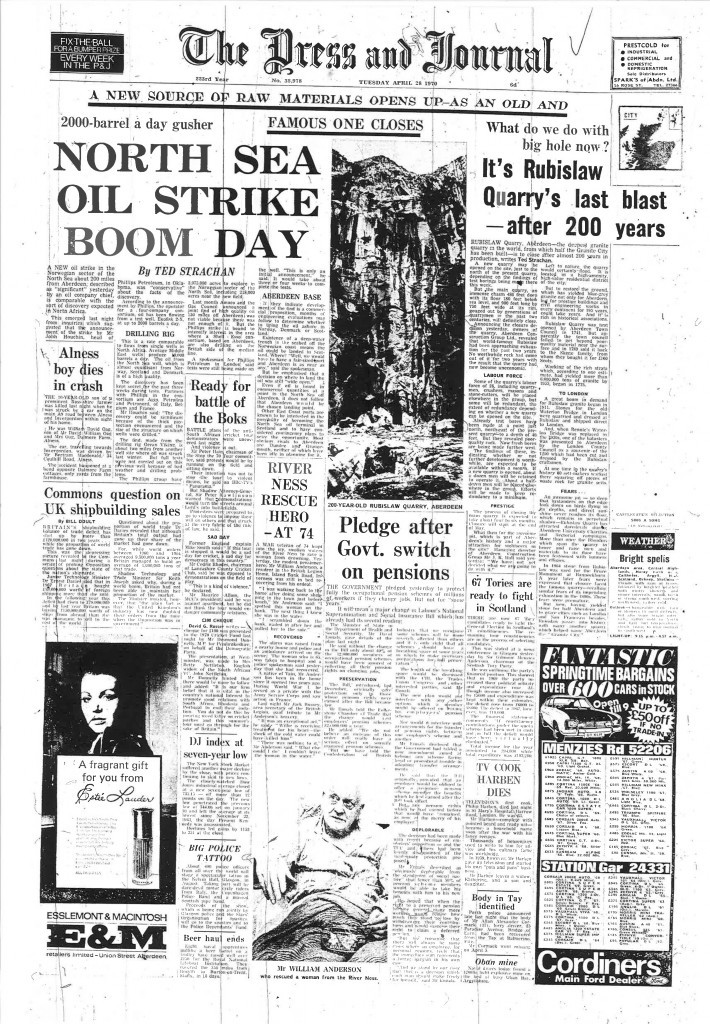
“A new source of raw materials opens up as an old and famous one closes”.
This was the headline which made the Press and Journal’s Ted Strachan famous as he heralded the end of Aberdeen’s quarry and the start of the North Sea oil and gas industry.
More than 40 years ago the industrial reporter raced against time to scoop a Norwegian publication about the Ekofisk oil discovery.
But the veteran journalist said he can’t take credit for the structure of the April 28th, 1970 front page – rather it was the foresight of the paper’s sub-editors – who placed both the story of the Rubislaw Quarry closure and the Ekofisk discovery alongside one another.
Energy Voice caught up with the former journalist at Offshore Europe as he reminisced about his front page scoop.
Ted said: “I was rather lucky to be credited with the very early story of the big oil in the North Sea and I was a little bit lucky there because a Stavanger newspaper had got in a little bit before that.
“Not surprising since it was in the Ekofisk field in the Norwegian sector. Funnily enough about six years previous to that I had been sent by our editor Jimmy Grant, a bit of a legendary editor then down to Glasgow to report on a speech and there was no North-east angle on the speech given by the then chairman of British Gas until he mentioned the oil exploration just beginning in the southern North Sea off Great Yarmouth and I thought ‘Oh well, there’s my angle’ because Aberdeen borders the North Sea as well.
“For several, half a dozen years before that, before the discovery of Ekofisk there wasn’t much in the oil except maybe occasionally Shell and BP up in Aberdeen except for exploration.
“A whole lot of other companies set up in what became a legendary address, bonded warehouse number five, the Aberdeen harbour, which became the big space of Asco subsequently.
“When Ekofisk was discovered a colleague in the fishery side of the Press and Journal, Jim Kinnaird, said to me “Ted you can bet, if they found oil there, they’ve found it in the UK sector as well, because the median lines is just median lines, the oil is not confined by that.
“So I wrote that story on the basis of further information. I think we got a hint of it – there was some movement in the BP price or an oil company price on Wall Street which the Press and Journal could just pick up in those days because it came out hours later than the central belt papers.
“It was a completely different world in those days. The then sub-editors of the Press and Journal had the wit to splash the story, the Ekofisk story, and in the same day it coincided with the closure of the Rubislaw Quarry so it was toss-up as to which would be the lead story and to their credit they saw the coming story was the Ekofisk one and that’s more or less how it started really.”
The lead story – or splash, as it’s known in newspaper parlance – proclaimed a 2,000-barrel a day gusher and a “North Sea oil strike boom day”.
The Ekofisk announcement came just weeks after Amoco announced a high quality oil strike 150 miles off Aberdeen but decided it was not viable because there was not enough of it.
At the time Ted wrote: “But the Phillips strike is bound to intensify interest in the area where a Shell-Esso consortium, based on Aberdeen, are also drilling on the British side of the median line.”
Strachan speculated that the Norwegian oil could come ashore in Aberdeen. He quoted a Phillips spokesman as saying: “Well, we would need a fair-sized port and Aberdeen is as near as any.” He added the decision on where to land the oil was still “wide open”.
